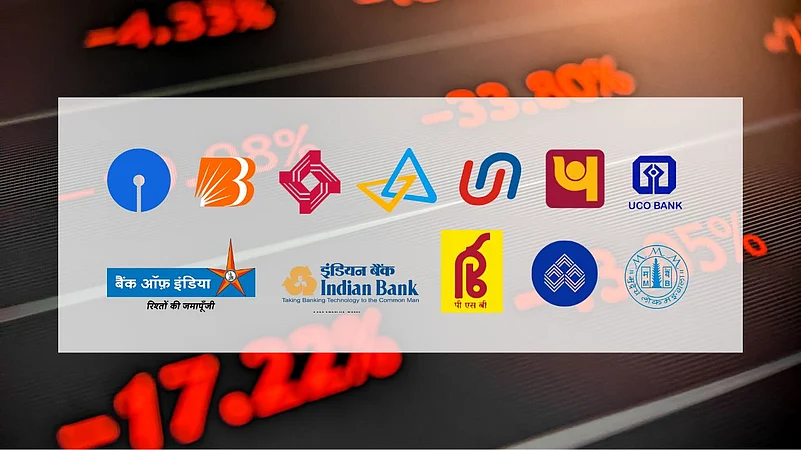PSU Bank Stocks, Bank of Baroda Share Price: The Nifty PSU Bank index fell as much as 5.15 per cent on May 6, emerging as the top sectoral loser. At day’s close, the 12-constituent index ended at 6,235.20, down 4.84 per cent. All the 12 public sector bank stocks ended the day in deep red.
Leading the losses was the Bank of Baroda, which fell 10.91 per cent. Bank of India (BOI) shares slumped 6.33 per cent and Union Bank of India shares declined 6.19 per cent. Indian Overseas Bank (IOB), Punjab & Sind Bank (PSB), Central Bank of India, and Canara Bank fell between 5 per cent to 6 per cent.
Other constituents of the index such as Punjab National Bank (PNB), Maharashtra Bank, UCO Bank, Indian Bank, and State Bank of India (SBI) also fell in the range 2 per cent to 5 per cent.
The Nifty PSU Bank index, so far in 2025, has yielded a negative return of 4.67 per cent, underperforming its private sector peer – Nifty Private Bank index, which meanwhile has gained nearly 9 per cent year-to-date (YTD). Nifty Bank, which tracks 10 major banking stocks across public and private sectors, is up 6.29 per cent YTD.
Nifty PSU Bank: What Triggered The Sharp Sell-Off
Manasvi Garg, a Securities and Exchange Board of India-registered investment advisor (Sebi RIA), CFA, and founder and CEO of Moneyvesta said the sharp fall in Nifty PSU Bank index reflects growing investor concern over the performance and outlook of public sector banks. He told Outlook Money: “The trigger came from Bank of Baroda’s Q4 FY25 earnings, which reported weak numbers. Its net interest income (NII) fell by 6.6 per cent year-on-year (YoY).”
Of the top five public sector banks, only two have reported their Q4 earnings so far, and both have delivered disappointing results, noted Garg, while adding, “This is leading to market fears that other large PSU banks yet to report may also follow a similar trend.”
“India’s largest PSU bank, State Bank of India (SBI), posted a mild NII growth of 2.7 per cent, but its profit after tax (PAT) fell by 9.9 per cent, indicating margin pressure,” he said.
SBI and Bank of Baroda together account for 48.85 per cent of the Nifty PSU Bank index, representing nearly half its total weight.
Bank of Baroda Q4 FY25 Results
Bank of Baroda, India’s second-largest public sector bank by market capitalisation, reported a 3.3 per cent YoY growth in its standalone net profit for the March quarter, at Rs 5,048 crore. In the same quarter last year, it had reported a net profit of Rs 4,886 crore. The PSU bank’s interest income for the quarter under review grew 3.6 per cent to Rs 30,642 crore, and interest expenses jumped 10 per cent to Rs 19,622.39 crore.
Its NII declined by 6.6 per cent YoY, as mentioned above, to Rs 11,020 crore from Rs 11,793 crore. The bank’s operating profit remained largely flat, rising just 0.3 per cent to Rs 8,132 crore in Q4 FY25 from Rs 8,106 crore in the year-ago quarter.
On the asset quality front, the bank’s gross non-performing assets (GNPA) shrank 66 basis points (bps) YoY to 2.26 per cent. Net NPA (NNPA) also declined by 10 bps YoY to 0.58 per cent.
Total deposits in the bank, however, grew 10.3 per cent YoY to Rs 14.72 lakh crore by the end of March 2025.
What Is Ailing PSU Banks
Garg pointed out three major pain points of PSU Banks. They are:
Post-June Pressure After a Massive Two-Year Rally: After making a peak in June 2024, the Nifty PSU Bank Index has been under consistent pressure. This comes after an impressive 150 per cent plus rally in the last two years, driven by improving asset quality, strong credit growth, and improved operating metrics. At its peak, the index traded at 1.8 times its price-to-book value, which is a premium valuation for PSU banks historically. The recent correction suggests that investors are now rethinking those high valuations, especially with earnings coming in weak.
Retail Participation Impacting Deposit Growth: A significant rise in retail equity market participation post-Covid is seen as a negative for deposit growth. With more individuals deploying funds in markets and mutual funds rather than bank deposits, PSU banks are struggling to keep pace with credit growth.
Rate Cut Cycle and NIM Contraction Ahead: India is possibly now in a rate cut cycle, and this has an asymmetrical impact on banks:
Credit rates are repriced quickly, which reduces interest income.
Deposit rates adjust with a lag, meaning the cost of funds remains elevated in the near term.
“This puts direct pressure on NIMs. The full impact of the recent rate cuts will be visible in the next quarter’s earnings, and markets are already pricing in further NIM contraction,” Garg said.










